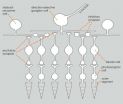(Press-News.org) Mom's comforting tuck-them-in-words — "Sleep tight, don't let the bedbugs bite"— is becoming an impossible dream for millions of people as the world experiences a resurgence of an ancient scourge that is fostering human misery, financial burdens and the risk of exposure to potentially toxic materials. That's the message from the cover story of the current edition of Chemical & Engineering News (C&EN), ACS' weekly newsmagazine.
In the article, C&EN News Editor William G. Schulz points out that bedbugs represent a growing epidemic that is difficult to control. The bugs hide in mattresses, box springs, nightstands, and other areas, emerging at night to dine on human blood. Their bites can cause allergic skin reactions, mental anguish, and loss of sleep. Infestations can be a financial burden, with professional extermination sometimes costing thousands of dollars and taking eight weeks or more. Some chemicals that were once effective against the pests, such as DDT, have been banned due to threats to human health and the environment, leaving exterminators with few effective options for controlling the pests, which have developed the ability to shrug-off some pesticides.
But the fight against bedbugs is intensifying. Scientists are looking for new substances to fight bedbugs that are safe and effective. Officials in Ohio — "bedbug ground zero' — are seeking Federal government permission to resume use of a pesticide called propoxur that can quickly halt infestations. Propoxur was pulled from the market by its manufacturer after EPA raised safety and efficacy concerns. For now, a combination of pesticides and preventive measures, such as regular inspection, laundering, vacuuming, removing clutter, and sealing up cracks in walls and baseboards, are among the best ways to control the bugs, the article notes.
###
ARTICLE FOR IMMEDIATE RELEASE
"Battling the Bedbug Epidemic"
Battling the bedbug epidemic
2011-03-10
ELSE PRESS RELEASES FROM THIS DATE:
Pinpointing air pollution's effects on the heart
2011-03-10
Scientists are untangling how the tiniest pollution particles – which we take in with every breath we breathe – affect our health, making people more vulnerable to cardiovascular and respiratory problems. While scientists know that air pollution can aggravate heart problems, showing exactly how it does so has been challenging.
In a study published recently in the journal Environmental Health Perspectives, scientists showed that in people with diabetes, breathing ultrafine particles can activate platelets, cells in the blood that normally reduce bleeding from a wound, ...
Study shows how plants sort and eliminate genes over millennia
2011-03-10
WEST LAFAYETTE, Ind. - Hybrid plants with multiple genome copies show evidence of preferential treatment of the genes from one ancient parent over the genes of the other parent, even to the point where some of the unfavored genes eventually are deleted.
Brian Dilkes, an assistant professor of genetics at Purdue University, worked with a team of scientists at the University of California Davis and University of Southern California to study the genome of Arabidopsis suecica, a hybrid species with four chromosome sets formed tens of thousands of years ago from a cross between ...
What's in a name? Broadening the biological lexicon to bolster translational research
2011-03-10
So-called model organisms have long been at the core of biomedical research, allowing scientists to study the ins and outs of human disorders in non-human subjects.
In the ideal, such models accurately recapitulate a human disorder so that, for example, the Parkinson's disease observed in a rat model would be virtually indistinguishable from that in a human patient. The reality, of course, is that rats aren't human, and few models actually faithfully reflect the phenotype of the disease in question. Thus, in the strictest sense of the word, many "models" aren't truly ...
Novel method could improve the performance of proteins used therapeutically
2011-03-10
FINDINGS: Whitehead Institute scientists have created a method that uses the enzyme sortase A to site-specifically modify proteins. Using this technique, researchers were able to increase potency, slow the metabolism, and improve thermal stability of several proteins, including interferon alpha 2 (IFN-alpha 2) and granulocyte colony-stimulating factor 3 (GCSF-3). IFN-alpha 2 is used to treat a variety of diseases, including leukemia, melanoma, and chronic hepatitis C, while GCSF-3 (known as filgrastim and marketed as Neupogen®) is administered to patients with neutropenia.
RELEVANCE: ...
First international index developed to predict suicidal behavior
2011-03-10
Although thousands of people commit suicide worldwide each year, researchers and doctors do not have any method for evaluating a person's likelihood of thinking about or trying to commit suicide. An international group of scientists, in which the Hospital del Mar Research Institute (IMIM) has participated, has devised the first risk index in order to prevent suicides.
"It is of key importance to identify suicidal thoughts among people at increased risk. The most important contribution that our study has made is an international risk index to estimate the likelihood of ...
More reasons to be nice: It's less work for everyone
2011-03-10
A polite act shows respect. But a new study of a common etiquette—holding a door for someone—suggests that courtesy may have a more practical, though unconscious, shared motivation: to reduce the work for those involved. The research, by Joseph P. Santamaria and David A. Rosenbaum of Pennsylvania State University, is the first to combine two fields of study ordinarily considered unrelated: altruism and motor control. It is to be published in a forthcoming issue of Psychological Science, a journal of the Association for Psychological Science.
"The way etiquette has been ...
Rutgers researchers identify materials that may deliver more 'bounce'
2011-03-10
NEW BRUNSWICK, N.J. – Rutgers researchers have identified a class of high-strength metal alloys that show potential to make springs, sensors and switches smaller and more responsive.
The alloys could be used in springier blood vessel stents, sensitive microphones, powerful loudspeakers, and components that boost the performance of medical imaging equipment, security systems and clean-burning gasoline and diesel engines.
While these nanostructured metal alloys are not new – they are used in turbine blades and other parts demanding strength under extreme conditions – ...
When leukemia returns, gene that mediates response to key drug often mutated
2011-03-10
(MEMPHIS, Tenn. – March 9, 2011) Despite dramatically improved survival rates for childhood acute lymphoblastic leukemia (ALL), relapse remains a leading cause of death from the disease. Work led by St. Jude Children's Research Hospital investigators identified mutations in a gene named CREBBP that may help the cancer resist steroid treatment and fuel ALL's return.
CREBBP plays an important role in normal blood cell development, helping to switch other genes on and off. In this study, researchers found that 18.3 percent of the 71 relapsed-ALL patients carried alterations ...
Gene variant influences chronic kidney disease risk
2011-03-10
A team of researchers from the United States and Europe has identified a single genetic mutation in the CUBN gene that is associated with albuminuria both with and without diabetes. Albuminuria is a condition caused by the leaking of the protein albumin into the urine, which is an indication of kidney disease.
The research team, known as the CKDGen Consortium, examined data from several genome-wide association studies to identify missense variant (I2984V) in the CUBN gene. The association between the CUBN variant and albuminuria was observed in 63,153 individuals with ...
New microscope decodes complex eye circuitry
2011-03-10
VIDEO:
Ganglion cells preferentially form synapses with those amacrine cells whose dendrites run in the direction opposite -- seen from the ganglion cell - to the preferred direction of motion (amacrine...
Click here for more information.
The sensory cells in the retina of the mammalian eye convert light stimuli into electrical signals and transmit them via downstream interneurons to the retinal ganglion cells which, in turn, forward them to the brain. The interneurons ...


